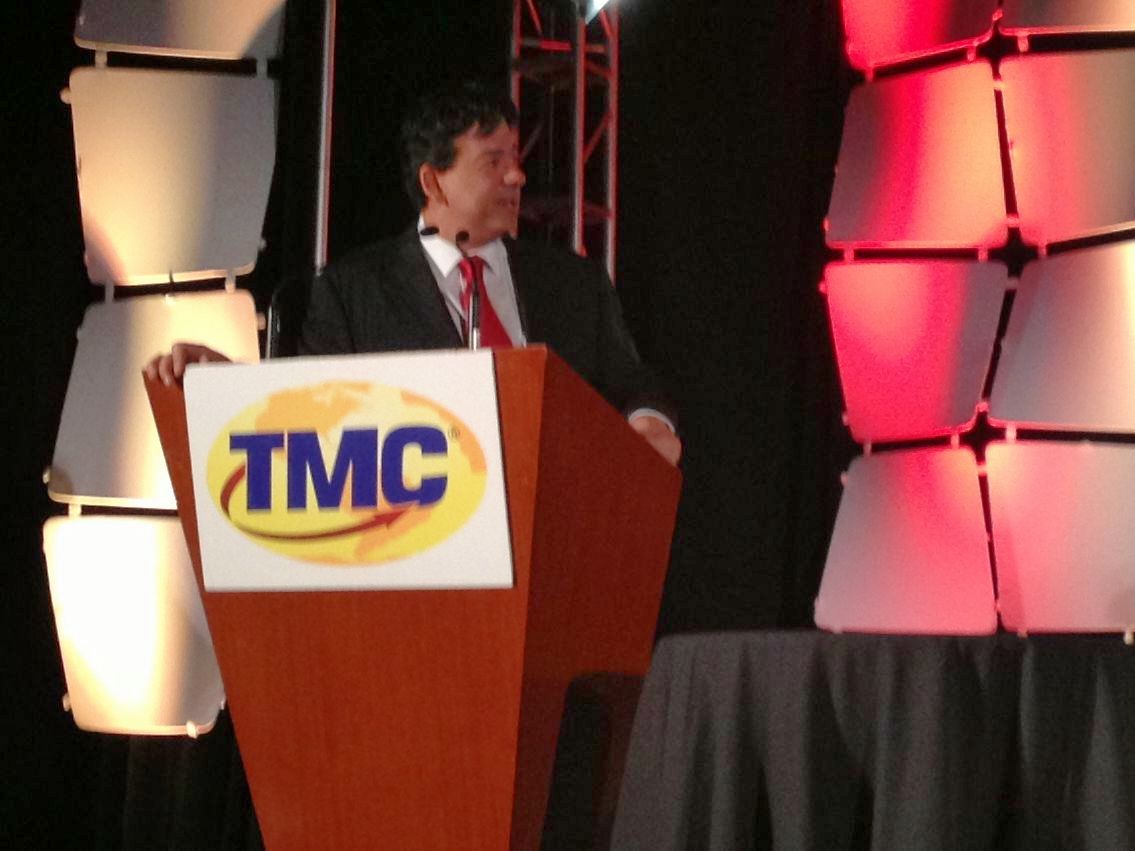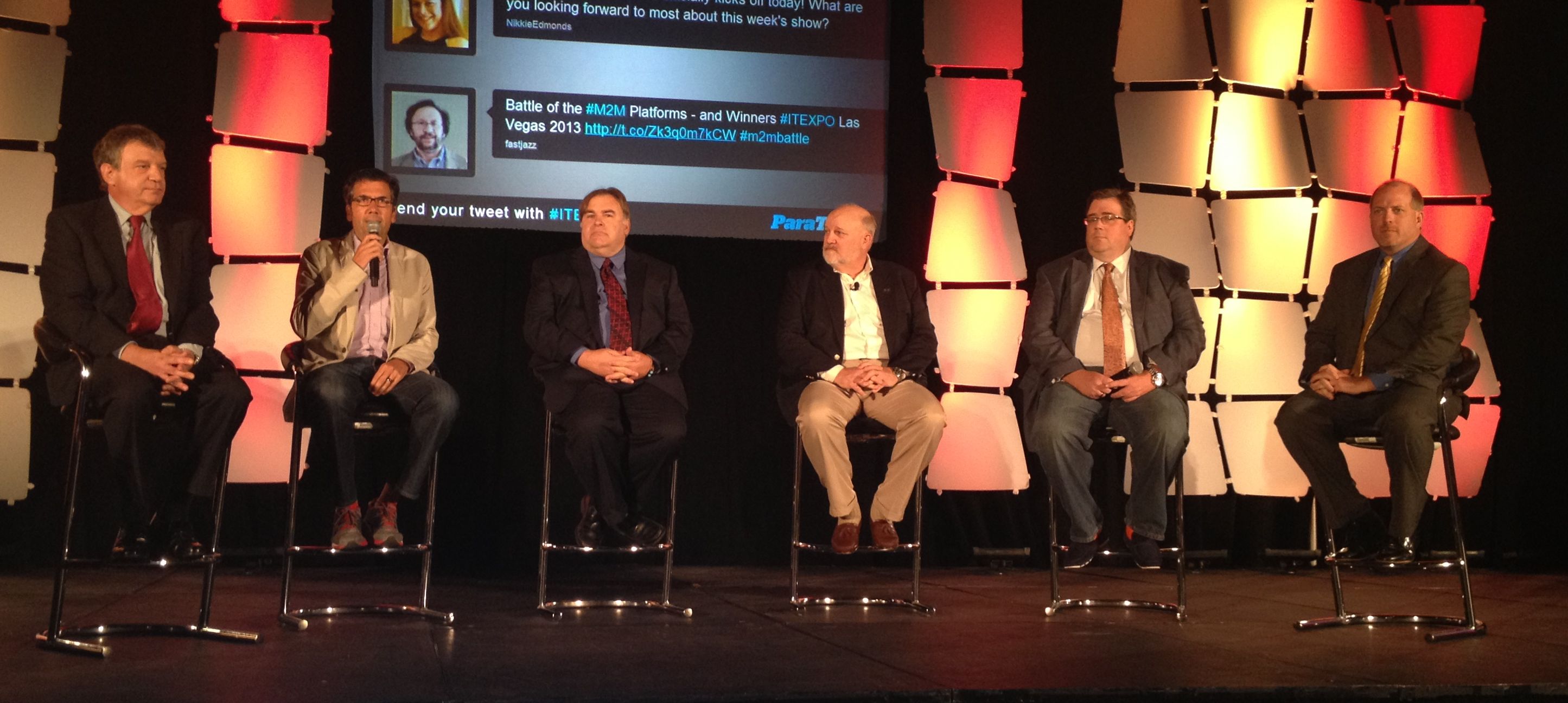TMC CEO Rich Tehrani led an intriguing keynote panel discussion at ITEXPO on August 27, 2013 that focused on Technology Innovation in Today’s Cloud and Mobile World. The panel itself consisted of what I will refer to as six “known contrarians” – not only to ourselves but to the tech world at large. We can certainly say that Tehrani, shown below, had his hands full trying to contain them throughout the session. We have our hands full as well trying to summarize otherwise detailed and very stimulating thoughts and ideas.

TMC CEO Rich Tehrani
In the photo below we have, from left to right, TMC senior editor Peter Bernstein, Larry Lisser of Embrase, Carl Ford of Crossfire Media, Phil Edholm of PKE Consulting, James Brehm from Compass Intelligence and TMC group editorial director Erik Linask.

Peter Bernstein starts things off by noting that mobility and cloud computing get his votes for key trends, which he distinguished from “technologies” – among which he listed html5 and WebRTC as key technologies. There certainly isn’t anything to take exception with here.
Larry Lisser, who also runs ITEXPO’s StartupCamp event, has an entirely different take, suggesting that the idea of Do It Yourself (DIY) Web creation and building things from the ground up will become very powerful differentiators in how both cloud and mobile technology will manifest itself.
Carl suggests that hardware is a key driver for how things will evolve, and noted as an example that automobiles are changing dramatically. He notes that higher end cars now sport as many as 200+ sensors, and that in combination with software development becoming easier, we will see a proliferation of smart devices.
For Phil Edholm, who lives and breathes WebRTC these days, the cloud, ubiquitous bandwidth (bandwidth is always there and is always getting better), devices (cars and smart TVs are also “devices”), and of course WebRTC are key trends. These collections of devices are rapidly evolving into ever smarter devices – and because of cloud and bandwidth availability they have really evolved into intelligent communications access points. This means that most software technology and processing power will sit in the cloud.
James Brehm, a major advocate for all things machine 2 machine (M2M) takes yet a different but related view. He suggests that contextualization and relevance of information and data will be the key trends to how we use technology. Given his M2M interests, it isn’t surprising that he also notes that creating a unified collection of devices that understand each other and work together in user-meaningful ways will be critical for advancing the state of the industry.
The Power of One
Erik Linask picks up on Brehm’s theme, and notes that the underlying foundation for driving cloud and mobile technology forward rests with how well end user and customer experiences and interactions are handled. Ultimately it all comes down to how delighted users are with the mobile and cloud services provided. Lisser fully agrees that the customer is key to technology enablement.
Following on the end user theme, Bernstein points out that both identity management and context mediation will be critical to the user experience. Identity and personal brand need to be protected and, as a result, the user will continue to gain better control and power over what Peter refers to as their own personal brand value. For Peter, the Holy Grail will be for users to be able to monetize their “brand” – which rests on protecting identity.
Edholm follows up by noting that WebRTC will change how we interact with technology as individuals, whether that interaction is between people or between websites and people. Phil believes that WebRTC will establish new communications channels, with the end user becoming more central to the entire process. Think of even the most interactive website becoming a static entity when compared to adding video-based interactive users to the mix on a regular basis through WebRTC.
Brehm goes so far as to suggest that there will very soon no longer be a need to invest in SEO. With the power of the individual becoming prevalent marketers will need to move away from aggregated identity to a model of understanding individual identity. James asks: “How do individuals ‘monetize’ their identities as marketers look to take advantage of individual, rather than aggregated, identity?”
He comes around again to noting that marketers will do so by building in individual contextuality and relevance of information to each specific user. Relevance of information goes both ways as individuals and customers both need this context-related ability to measure and access relevance. Bernstein agrees, noting that there have to be ways to effectively monetize, and this requires filtering of information. James also notes that a marketer once told him that individuals have a very specific value - $108. Our colleague Paula Bernier elaborates on this directly.
Edholm refers to this as “focused advertising.” Phil notes that it will be critical to making much more efficient use of our time for marketing and advertising to be far better mediated. This does require gathering information – often in massive quantities, that can then be analyzed for relevance details. Brehm, in turn, wonders how we as end users can control privacy over hundreds of devices – which in many cases will include things that we, as end users, may not be thinking of as hardware that gathers and sends out information about us. This “hardware we don’t think about” includes Internet-connected (typically through Wi-Fi) smart refrigerators, smart TVs, and so on. All appliances – even your trusty toaster – can be and will be turned into information-gathering tools. James wonders if we will all simply look to “disconnect” at some point.
Linask makes a very important point in response to this question. Erik underscores that while we adults may worry about this sort of thing, our kids will continue to freely connect, interact, record everything and share – this means that the real answer is that no, ultimately the future is one where we will all be connected and Erik notes, as well, that this means analytics companies are going to be sitting pretty.
Edholm certainly agrees that everything – including what you say - you say will be recorded and very likely captured in video.
Well, as these things always go, no sooner did the panel set up an array of insights to debate in detail that the session came to a close. Alas, our summary misses more things than it captures, but we believe that it does underscore the very interesting issues that emerged. Key to this is that even though technology – devices, the cloud, wireless bandwidth - is evolving at a constantly rapid pace (does anyone doubt that in two years we will look at today’s mobile toys and wireless access as antiquated and barely usable?) the most powerful thing that will emerge from all of this “collective tech” won’t be the tech itself but rather the power the tech will give the individual – either as a consumer or as a customer. This means, of course, that technology ends up giving us more power as individuals – or “the power of one.”
It is a very intriguing thought, but one fraught with all sorts of potential pitfalls. As the panel discussed, protecting the user’s individual brand and identity is key here – but it is an enormous challenge to do so – especially as our next generation of users is so willing to give away so much in the name of “sharing.” The next generation will, no doubt, eventually come to regret all that technology-enabled sharing as they get older and realize that they may have lost that power of one – or, put another way, the power of the individual.
We ourselves were left thinking that the key issue surrounding next generation technology innovation will involve figuring out how we, as the current generation, can effectively engage with the next generation to ensure that they understand and responsibly deal with not only the benefits but with the dangers to their personal identities and personal brands. As the saying goes, “Along with great power comes great responsibility.” The great power side of it is easy. The great responsibility end of it is infinitely difficult. The current generation needs to grab the bull by the horns here and do some wrestling.
Edited by
Ryan Sartor